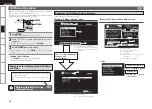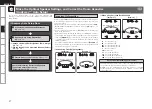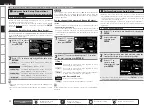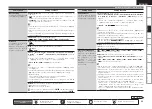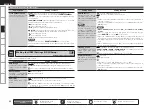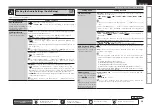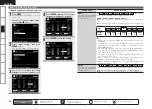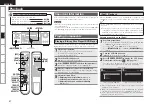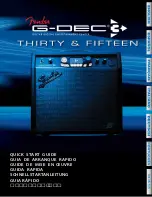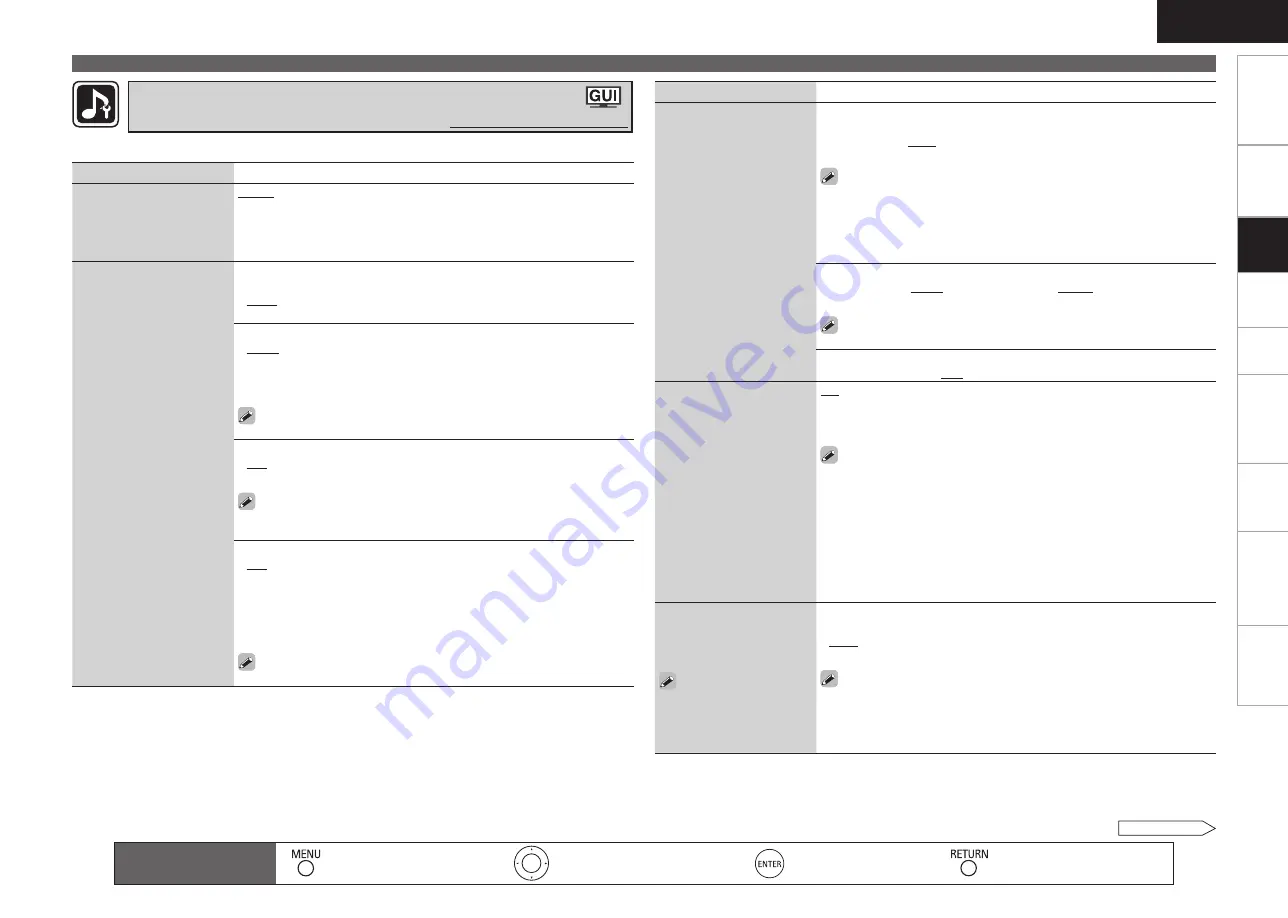
Get
ting Star
ted
Connections
Pla
ybac
k
Remot
e Contr
ol
ZONE2
Inf
or
mation
Tr
oubleshooting
Specifications
ENGLISH
Making Detailed Settings (Manual Setup)
Setting items
Setting contents
EXT. IN SW Level
Set the playback level of the
analog subwoofer signals in-
put from the external input
terminals (EXT. IN).
+15dB :
This is the recommended level.
+10dB / +5dB / 0dB :
Select the level according to the player being
used.
2ch Direct/Stereo
Make speaker settings for 2-
channel mode playback.
Setting :
Select the method for setting the speakers used in the 2-channel
direct and stereo playback modes.
Basic :
The settings at “Speaker Setup” (
v
page 33) are applied.
Custom :
Make separate settings for 2-channel.
•
•
Front :
Set the front speaker size.
Large :
Use of a large speaker that can adequately playback low
frequencies.
Small :
Use of a small speaker that has inadequate playback capacity for
low frequencies.
If “Speaker Configuration” – “Subwoofer” (
v
page 33) is set to
“No”, the setting is automatically set to “Large”.
•
•
Subwoofer :
Set the presence of a subwoofer.
Yes :
Use a subwoofer.
No :
Select when a subwoofer is not connected.
If “Speaker Configuration” – “Subwoofer” (
v
page 33) is set to
“No”, the setting is automatically set to “No”. If the “Front” setting is
“Small”, the setting is automatically “Yes”.
•
•
SW Mode :
Select low range signal to be reproduced by subwoofer.
LFE :
When the “2ch Direct/Stereo” – “Front” setting is set to “Large”,
the LFE signal alone is output from the subwoofer. Also, when the “2ch
Direct/Stereo” – “Front” setting is set to “Small”, the front channel low
range signal is added to the LFE signal output from the subwoofer.
LFE+Main :
The front channel low range signal is added to the LFE signal
output from the subwoofer.
This can be set when “2ch Direct/Stereo” – “Subwoofer” is set to
“Yes”.
•
•
Make settings for audio playback.
Making the Audio Settings (Audio Setup)
Default settings are underlined.
Setting items
Setting contents
2ch Direct/Stereo
(Continued)
Crossover :
Outputs at below set frequency, each speaker’s bass signal
output from the subwoofer.
40Hz
/
60Hz
/
80Hz
/
90Hz
/
100Hz
/
110Hz
/
120Hz
/
150Hz
/
200Hz
/
250Hz
This can be set when “2ch Direct/Stereo” – “Subwoofer” is set to
“Yes”.
If the “2ch Direct/Stereo” – “Front” setting is “Large” and the “SW
Mode” setting is “LFE”, “Full Band” is displayed and the setting cannot
be made.
•
•
•
Distance FL
/
Distance FR :
Select the speaker.
0.0ft
~
60.0ft
(
12.0ft
) /
0.00m
~
18.00m
(
3.60m
)
:
Set the distance to
the speaker.
Set so that the difference between the front left speaker and front
right speaker distances is 6.0 m (20.0 ft) or less.
•
Level FL
/
Level FR :
Select the speaker.
–12.0dB
~
+12.0dB
(
0dB
)
:
Adjust the level of each channel.
•
Auto Surround Mode
Make setting for memorizing
surround mode setting for
each input signal type.
ON :
Memorize settings. Automatically play with the last used surround
mode.
OFF :
Do not memorize settings. Surround mode does not change
according to input signal
The auto surround mode function lets you store in the memory the
surround mode last used for playing the four types of input signals listed
below.
q
Analog and PCM 2-channel signals
w
Dolby Digital and DTS 2-channel signals
e
Dolby Digital and DTS multi-channel signals
r
Multi-channel signals other than Dolby Digital and DTS (PCM etc.)
When playing in the PURE DIRECT, the surround mode does not change
even if the input signal is changed.
•
•
EQ Customize
Set so that unused equalizer
settings are not displayed
when
MULTEQ
is pressed.
Equalizer settings for which
“Not Used” is set with the
Quick Select function cannot
be stored and called out.
Audyssey Byp. L/R :
Set when not using the “Audyssey Byp L/R”
equalizer.
Used :
Use.
Not Used :
Do not use.
Set so that “Audyssey Byp. L/R” settings can be made when
Audyssey™ Auto Setup procedure is performed.
•
•
Remote control operation
buttons
:Displaying the menu
Cancel the menu
:Moves the cursor
(Up/Down/Left/Right)
:Confirm the setting
:Return to previous menu
Set
tin
g
s
See overleaf




